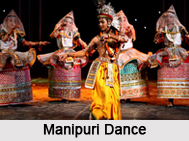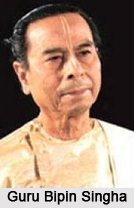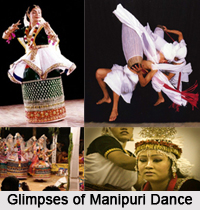 Manipuri Dance is the classical dance from the Manipur region in the North East. The Manipuri dancers are the great personalities who have supported this dance form in gaining a distinct structure whilst echoing the sheer aura of antiquity. The Manipuri dancers with their immense creativity have made a difference to Bishnupriya Manipuri society in the fields of dance and performing arts. Because of its ecological location, the people of Manipur have been protected from outside controls, and this region has been capable to keep hold of its unique traditional culture.
Manipuri Dance is the classical dance from the Manipur region in the North East. The Manipuri dancers are the great personalities who have supported this dance form in gaining a distinct structure whilst echoing the sheer aura of antiquity. The Manipuri dancers with their immense creativity have made a difference to Bishnupriya Manipuri society in the fields of dance and performing arts. Because of its ecological location, the people of Manipur have been protected from outside controls, and this region has been capable to keep hold of its unique traditional culture.
The Manipuri dance is among the major classical dance forms of India, particularly noted for themes based on "Vaishnavism" and stunning execution of "Ras Lila", dance dramas based on love between Radha and Krishna.
Histoty of Manipuri Dancers
 The history of Manipuri dancers is as old as the dance form. Usually the Manipuri people believe themselves to be the "Gandharvas" mentioned in the Vedic texts who were singers, dancers and musicians connected with "devas" or the "deities". The first reference of Manipuri dancers dates back to the denotation of a copper plate inscription of 2nd century. It was then the reign of King Khuoyi Tompok. However, the style of the Manipuri dancers in those days resembled a typical form which was later named as "Krishna Bhakti" form. Maharaja Bhagyachandra, who is considered as the great connoisseur of Manipuri dance in the later days compiled the style of the dance into types like, Ras Lilas, the Maha Ras, the Basanta Ras and the Kunja Ras and the Manipuri dancers also changed their style in accord to that. This was the beginning of a new theme in Manipuri dance style where the Manipuri dancers wore the elaborate costumes, known as the "Kumil". The Manipuri dancers were traditionally indigenous to Manipur, however with passing years; many aspirant dancers have learnt this classical dance and became famous Manipuri dancers.
The history of Manipuri dancers is as old as the dance form. Usually the Manipuri people believe themselves to be the "Gandharvas" mentioned in the Vedic texts who were singers, dancers and musicians connected with "devas" or the "deities". The first reference of Manipuri dancers dates back to the denotation of a copper plate inscription of 2nd century. It was then the reign of King Khuoyi Tompok. However, the style of the Manipuri dancers in those days resembled a typical form which was later named as "Krishna Bhakti" form. Maharaja Bhagyachandra, who is considered as the great connoisseur of Manipuri dance in the later days compiled the style of the dance into types like, Ras Lilas, the Maha Ras, the Basanta Ras and the Kunja Ras and the Manipuri dancers also changed their style in accord to that. This was the beginning of a new theme in Manipuri dance style where the Manipuri dancers wore the elaborate costumes, known as the "Kumil". The Manipuri dancers were traditionally indigenous to Manipur, however with passing years; many aspirant dancers have learnt this classical dance and became famous Manipuri dancers.
Association with Rabindranath Tagore
Rabindranath Tagore reawakened the Manipuri dance art in a new way. He was so mesmerized by the presentation of the dance composition of "Goshtha Lila" in "Sylhet" (now in Bangladesh) in 1919 that he offered "Guru Budhimantra Singh", an leading Manipuri dancer, to join the faculty of "Shantiniketan", an Indian cultural and study centre. Guru Naba Kumar, the Manipuri dancer joined the faculty in Shantiniketan to teach the Raslila in 1926. Other celebrated Manipuri dancers include Senarik Singh Rajkumar, Nileshwar Mukharji and Atomba Singh, who were also invited to teach there and assisted Tagore with the choreography of several of his dance-dramas.
Presentation of Manipuri Dancers
 Manipuri dancers" main expression is devotional in character and is solely connected to Hindu Deities Radha and Krishna. The delicate steps, slow and gracious movements and the exquisite appeal of the Manipuri dancers offered this genre of dance form a distinct character. Manipuri as a dance style gradually became popular even outside the native. Guru Naba Kumar is one of the famous Manipuri dancers who went to Ahmadabad to teach Manipuri dance in 1928. Soon, Guru Bipin Singha popularized this particular dance form in Mumbai. Amongst his pupils, most well known Manipuri dancers are the Jhaveri sisters, Suverna, Nayana, Darshana and Ranjana. Apart from them other famous Manipuri dancers are Bhimavati Devi who is the daughter of Guru Bipin Singha.
Manipuri dancers" main expression is devotional in character and is solely connected to Hindu Deities Radha and Krishna. The delicate steps, slow and gracious movements and the exquisite appeal of the Manipuri dancers offered this genre of dance form a distinct character. Manipuri as a dance style gradually became popular even outside the native. Guru Naba Kumar is one of the famous Manipuri dancers who went to Ahmadabad to teach Manipuri dance in 1928. Soon, Guru Bipin Singha popularized this particular dance form in Mumbai. Amongst his pupils, most well known Manipuri dancers are the Jhaveri sisters, Suverna, Nayana, Darshana and Ranjana. Apart from them other famous Manipuri dancers are Bhimavati Devi who is the daughter of Guru Bipin Singha.
Manipuri dance is still regarded as the medium of worship and enjoyment and a door to the divine. From the religious point of view and from the artistic angle of vision, Manipuri dancers are some of the personalities who therefore practice the most modest, chestiest, softest and mildest and also the most meaningful dances of the world. The most courteous aspect of Manipuri culture is that, the Manipuri dancers has retained the ancient ritual based dances and folk dances along with the later developed classical Manipuri dance style. Among the classical categories, Manipuri dancers extensively popularized `Ras Leela`, a highly evolved dance drama, usually choreographed on `Vaishnavite Padavalis`. Besides, these dance styles, the Manipuri dancers poised for many more manifestations of the song, dance and martial arts culture that is fundamental to the people of Manipur. With the passing decades, Manipuri dance have been greatly categorized into various other forms and styles. The Manipuri dancers have done great justice to all the Manipuri dance styles both nationally and internationally. They have introduced innovative dance styles like Gouralila, Thang Ta, Nupi Pala, Dhop Kirtan, Ipom and so on.
The scenario of Manipuri dance could not have been as graceful as it is today, without the immense involvement of the talented Manipuri dancers like Guru Bipin Singha, Guru Nileshwar Mukherjee, Guru Senarik Rajkumar, Guru Chandrakanta Singha, Guru Nilmadhab Mukharjee, Guru Haricharan Singha, Kalabati Devi, Preeti Patel and Tamanna Rahman.



















